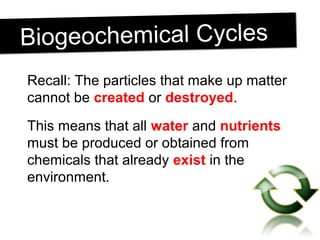Grade 9, U3-L4 Cycles
- 1. Cycling of MatterCycling of Matter in ecosystems
- 2. Biogeochemical CyclesBiogeochemical Cycles Recall: The particles that make up matter cannot be created or destroyed. This means that all water and nutrients must be produced or obtained from chemicals that already exist in the environment.
- 3. This happens in a series of cycles in which chemicals are continuously consumed, rearranged, stored and used. Because these cycles involve living (bio) organisms and occur on Earth (geo), they are called biogeochemical cycles. Biogeochemical CyclesBiogeochemical Cycles
- 4. Every particle in every organism is part of a biogeochemical cycle! Biogeochemical CyclesBiogeochemical Cycles
- 5. Water cycle = the series of processes that cycles water through the environment Most of the water that is present in the water cycle is found in the abiotic environment. The Water CycleThe Water Cycle
- 7. Carbon moves between the abiotic and biotic parts of an ecosystem in the carbon cycle. Most of this exchange occurs between carbon dioxide (either in the atmosphere or dissolved in water) and photosynthesizing plants and micro organisms. The Carbon CycleThe Carbon Cycle
- 9. While large quantities of carbon cycle through photosynthesis and cellular respiration, most of Earth’s carbon is not cycled. Carbon DepositsCarbon Deposits
- 10. Carbon DepositsCarbon Deposits Instead, it is stored in carbon-rich deposits such as fossil fuels (coal, oil, natural gas etc.) that form when decomposed organisms are compressed over millions of years.
- 11. Carbon is also stored for millions of years as limestone formed from dead marine organisms.
- 12. Large quantities of carbon are also contained in plant tissue and as dissolved carbon dioxide in the world’s oceans. Carbon DepositsCarbon Deposits
- 13. These locations are referred to as carbon sinks because carbon can enter or leave them over relatively short periods of time. Carbon DepositsCarbon Deposits
- 14. Human activities have a dramatic impact on the carbon cycle. By burning fossil fuels, humans release the stored carbon into the atmosphere, which is contributing to global climate change. Human ImpactHuman Impact
- 15. Deforestation also increases the concentration of carbon dioxide in the atmosphere.
- 16. Nitrogen is extremely abundant in the atmosphere, however it is not easy to acquire directly from the abiotic environment. Nitrogen CycleNitrogen Cycle
- 17. Nitrogen enters and leaves the atmosphere through a complex biochemical pathway called the nitrogen cycle. Nitrogen CycleNitrogen Cycle
- 18. Most of the nitrogen used by living things is taken from the atmosphere by certain bacteria in a process called nitrogen fixation. Nitrogen CycleNitrogen Cycle
- 19. These micro-organisms convert nitrogen gas into a variety of nitrogen- containing compounds, including nitrates, nitrites and ammonia. Nitrogen CycleNitrogen Cycle
- 20. Lightning and UV light also fix small amounts of nitrogen.
- 21. In addition, humans add nitrogen to the soil as fertilizer. Nitrogen CycleNitrogen Cycle
- 22. Once in the soil ecosystem, the nitrogen- rich compounds are available to producers. After the nitrogen is absorbed, it is passed from producer to consumer and moves up the food chain. Nitrogen CycleNitrogen Cycle
- 23. Many animals consume more nitrogen than they can use, and excrete the excess in the form of urea or ammonia. Nitrogen CycleNitrogen Cycle
- 24. A dead organism’s nitrogen-rich compounds are taken in by decomposers, or are released back into the environment.
- 25. These compounds are either recycled again by soil micro-organisms, or they are converted by denitrifying bacteria back into nitrogen gas which then re-enters the atmosphere. Nitrogen CycleNitrogen Cycle

























